Description
1 Introduce
This exceptional 24oz coffee bag is created for coffee, showcasing their premium organic roasted coffee for the U.S. market. The packaging not only highlights the superior quality of the product but also provides excellent protection during filling, transportation, and distribution.
In this section, we will provide a more in-depth analysis of this outstanding coffee bag, and we hope it helps you find the perfect packaging solution for your products.
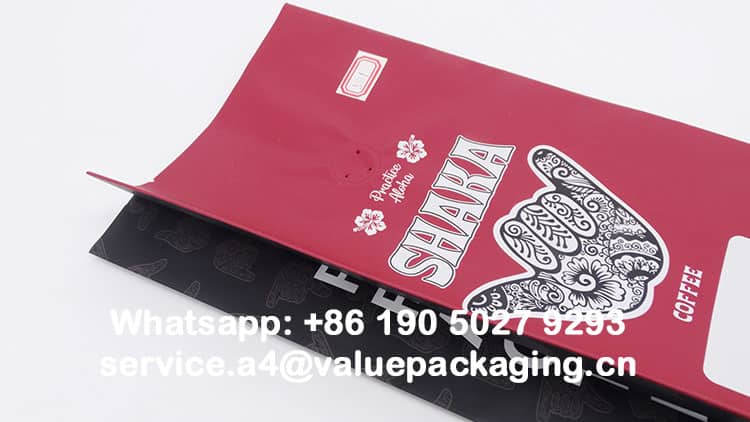
24oz boutique red coffee bag
Watch the video for this 24oz boutique red coffee bag
2 Foil Materials
This foil material is a reinforced structure with excellent properties for coffee bag packages. The foil structure is PET12/AL7/PET12/LDPE, with a graphic below.
Let’s first get a further understanding of each substrate layer material.
PET12, is one of the most commonly used printing substrates in flexible packaging pouches. With great optical clarity, high gloss, good chemical resistance, stable mechanical strength, excellent dimensional stability, and great printability, it can present the customer artwork print in great quality and also provide great mechanical strength to the final package.
Al7, is short for aluminum foil metal sheet with a thickness of 7 microns, which is the most commonly used thickness in flexible packaging. It has the best barrier performance among all the film materials, which can keep the original flavor and fragrance for a prolonged time. Aluminum foil is 98.5% aluminum, with the remaining percentage primarily made of iron and silicon to increase strength and puncture resistance. Finally, it is achieved with optical properties, such as durability, non-toxicity, oil-proofness, chemical resistance, and good thermal conductivity.
Second PET12, means a further layer of polyester film 12 microns applied between aluminum foil and the inner sealing layer, and finally contributes to a reinforced foil laminate. With an extra polyester film of 12 microns (short as PET12) applied, it can provide enough strength and standing profile for the finished multilayer package.
LDPE, means low-density polyethylene film, which is the most used inner sealing layer for coffee bags. LDPE is also lightweight, easy to fabricate, and has good chemical and impact resistance. LDPE is recyclable and reusable, making it a popular alternative to traditional plastic. LDPE is nontoxic, non-contaminating, and has a high degree of break resistance. Most importantly, LDPE membrane can be modified against the requirement of specific products, and finalize the package with great seal strength and protection. The thickness of the LDPE membrane will be decided against the particular application.
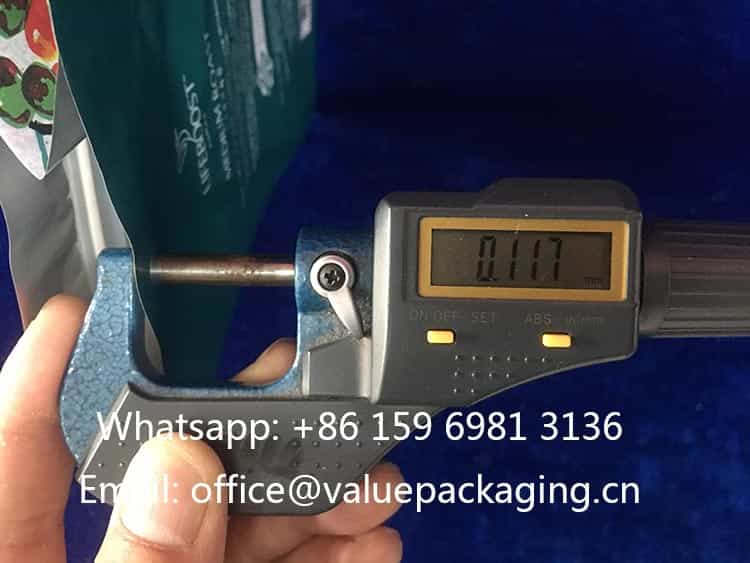
24oz boutique red coffee bag
The final thickness for this foil laminate should be 120 microns, with a tolerance +-5%. and the toughness will be enough to present a good standing effect for finished bags.
You may read here on our company website to get a deeper understanding of PET12/AL7/PET12/LDPE Foil Laminate and see how it can help you to decide the ideal packages.
3 Properties and Quality Assurance
3.1 Exquisite print quality
The artwork is printed using gravure printing on our rotogravure press, which supports up to 10 colors. With advanced printing techniques and a print defect inspection system in place, we are now delivering stunning print results for our customers’ designs.

24oz boutique red coffee bag
At our manufacturing facility, we implement strict measures to ensure high color fidelity and consistency across repeated print runs. In this section, we will provide a brief overview of our approach.
a. Color Analyzer
This color analyzer is one of the auxiliary tools in our system to achieve the highest standard for color fidelity. The eXact Advanced doesn’t just validate the color of CMYK and spot color inks, it can simultaneously measure four M modes to visualize the spectral reflectance of a substrate or ink, measure the concentration of a specific ink, and measure the difference of a substrate or ink over white and over black.
b. Pantone Color Code
The Pantone Color Guide is an invaluable tool for both print service suppliers and customers, especially when a large area is printed in a single Pantone color. It helps ensure consistency and precision in color selection. However, it’s important to note that the accuracy of Pantone colors can be influenced by several factors, such as the printer, the type of paper substrate, and environmental conditions when the color is printed onto physical media.
To address this, we collaborate closely with our customers to identify and confirm the exact Pantone Color Code in their artwork design before production begins. This proactive approach ensures that the final printed colors match the customer’s expectations as closely as possible, regardless of any external influences during the printing process.
c. Physical Printed On Photo Paper
You’re absolutely right—computer files such as JPG, PDF, PSD, AI, and others cannot be solely relied upon to determine color accuracy in print production, as these files display colors based on electronic screens. Different screens from various manufacturers can have different settings, such as brightness, contrast, and color profiles, which can lead to discrepancies in color presentation. This is why artwork files viewed on digital devices may not reflect the true color when printed.
Measures taken to achieve high color fidelity and consistency in reprints
3.2 Excellent Matte Finish Effect
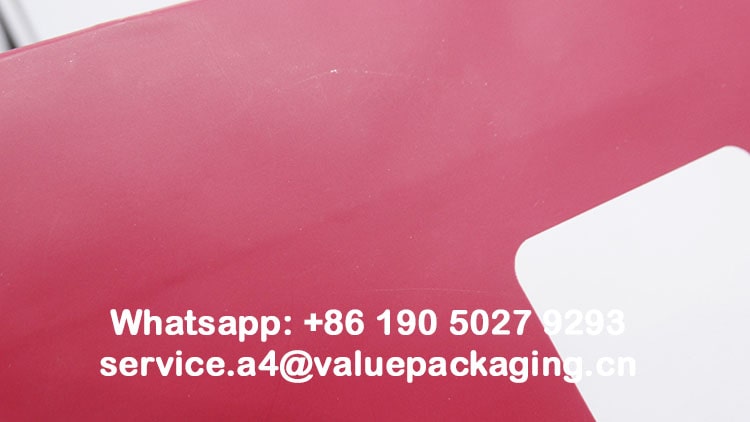
541-24oz-Coffee-bag-for-USA-customer
The matte finish effect of this amazing 24oz boutique red coffee bag is achieved by coating a layer of matte lacquer over the outside of the PET substrate layer, with great adhesion and uniformity. The lacquer layer is of great scratch resistance, which avoids the small hidden lines when the foil passes through the rollers during the bag-making process.
There are also some other options to achieve the matte finish effect for the coffee bag packages, and here you may this post if you are interested.
3.3 Excellent Dimension Stability
There is an increasing requirement for the dimension stability of the coffee bags when the roasters and packers are going to improve the production efficiency with high-speed filling lines. We get quite a good understanding on this ,and are doing our job to narrow the tolerance of the dimensions for each order produced in our long-term supply. Usually for the24oz coffee bag, the tolerance should be controlled within +-2%, which can run well on most of the high-speed filling machineries in the market.
3.4 Delicate Bag Making
The bag is achieved with delicate details, which can create a perfect impression for the consumers when they pass by the products, and cause them a purchase. Some customers do like to buy a product out of its gorgeous profile.

541-24oz-Coffee-bag-for-USA-customer1-min
3.5 High Barrier Performance
As explained previously, this foil laminate is finalized with a layer of thin aluminum metal sheet, which is of the best barrier performance against oxygen and moisture vapor. Usually, the roasted beans should be well protected to keep the original flavor and fragrance for a prolonged period, to enable the beans enjoyed by the end consumers.
3.6 Fantastic Standup Effect
The bottom of this 24oz coffee bag is much like a box when the roasted beans are filled, and that will make the package well stand up on the goods shelf, good for branding and sale.

541 24oz boutique red coffee bag
3.7 Great Mechanical Strength
This reinforced laminated foil can greatly protect coffee beans ranging from 100g to 5lb volume.
We perform various inspections and tests to check the mechanical strength of the finished pouch, like drop tests, hard sudden strikes, anti-pressure tests
- Tensile Strength
- Sealing Strength
- Anti-puncture Strength
- Burst Impact Strength
- Anti-pressure Property
The above tests are performed against each order, on customer requirements, and you may check the exact values of this foil material PET12/AL7/PET12/LDPE in the Technical Date Sheet part of this post.
3.8 Smooth Zipper
The tab zipper, also called rip zipper, enables the coffee pouch easily torn from the tab place, in a straight-line effect, and keeps the original integration of the package. You can see, the zipper is embedded into the coffee bag in a gorgeous way, without any wrinkles.

541-24oz-Coffee-bag-for-USA-customer
3.9 Easy Filling of coffee beans
A large opening can be achieved on the block bottom coffee bag, which enables the easy and fast filling of roasted beans into the pouch.
With the side gusset and bottom gusset, the bottom of this coffee bag is like a box (that’s why it is also called box bottom pouch), which makes the fall of the roasted beans much more easily into the bag.
You are advised to see the options of opening on block bottom box coffee bags for the current market.
3.10 Fine Air-release System
A degassing valve is applied neatly onto the coffee bag, which enable carbon dioxide to be released from the inside package under pressure of 2~7mbar.
With the development of biodegradable materials, the compostable one-way degassing valve is also available for compostable coffee packages.
4 Quality Control Measures
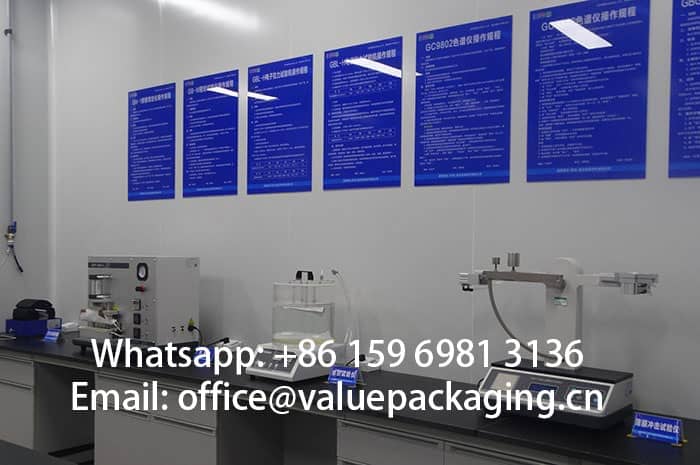
Labortory-test-equipment
Serious quality control measures have been taken in our manufacturing plant, to ensure each order is finished meeting the requirements of particular customers. With more than ten years of working experience in this field, we finalize this QC manual standard, to make sure each order is produced following the correct procedure.
Here, please allow us to guide you further into our QC system.
4.1 Manufacturing Traceback
We apply a strict recording system to document the manufacturing details, such as environmental conditions, craftsmanship parameters, production facility conditions, etc, which allows us to trace back whenever there is a problem.
4.2 QC Test Report Against Each Order
There will be a QC test report issued against each order produced, with the core items evaluated in it. It is highly appreciated by our customers.
You may read here to understand the QC test report for an order of 250g and 1000g coffee bags.
4.3 Print Inspection

Pantone-color-examine-purple
In our manufacturing plant, the print inspection is always taken and done in a serious way, as we will never allow the customer artwork to be achieved in a way that deteriorate their business. On our gravure print press, there is in-line inspection system which can eliminate more than 98% of the defects in the printing process.
You may check how it works on our control panel.
There is also a supplementary off-line inspection equipment, to allow us to do the print inspection again whenever it seems necessary.

off-line-gravure-print-inspection-for-roll-foils
We are now producing coffee bags against customer artwork, and we surely love to support the startup and market-testing period for our customers. We will accept a minimum order quantity of 10,000 bags printed against customer artwork design.
4.4 Airtight Property Test
The finished coffee bag should be completely airtight, to get the products well-protected from oxygen and moisture in the environment. We perform the airtight property test against each order with the device as below.
In actual operation, we will pick up 1 bag every 1,000 pcs, and perform the test following the procedure in our QC manual.
4.5 Gas Release Property Test

The gas will be released from the inside when the air pressure for the inside is 2~7 mbar than the outside environment. Usually, we will immerse the valve welded bag under the water, and check if the degassing valve works well.
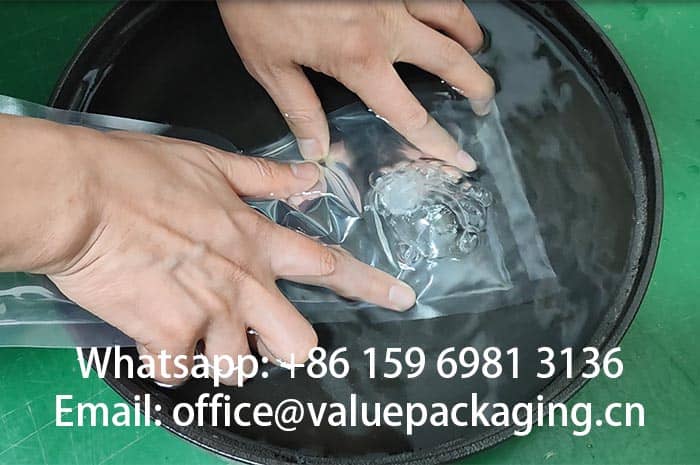
gas-relase-property-test-of-degassing-valve
4.6 Drop Test
Drop testing should be considered a very reliable way to check if the coffee bag’s strength is enough to meet the various conditions, as it replicates the way when the product falls off the good shelves, and the finished bag suffers a great sudden shock. In our daily QC work, we perform a drop test against each order. Of course, the standard for this drop test should be decided against customer needs.
Here, we are going to drop the filled coffee bag from 1.6m high, for 5 times.

You are advised to watch the video below, for a further understanding.
After 5 drops for each bag, none of them breaks, all are fine and dandy.
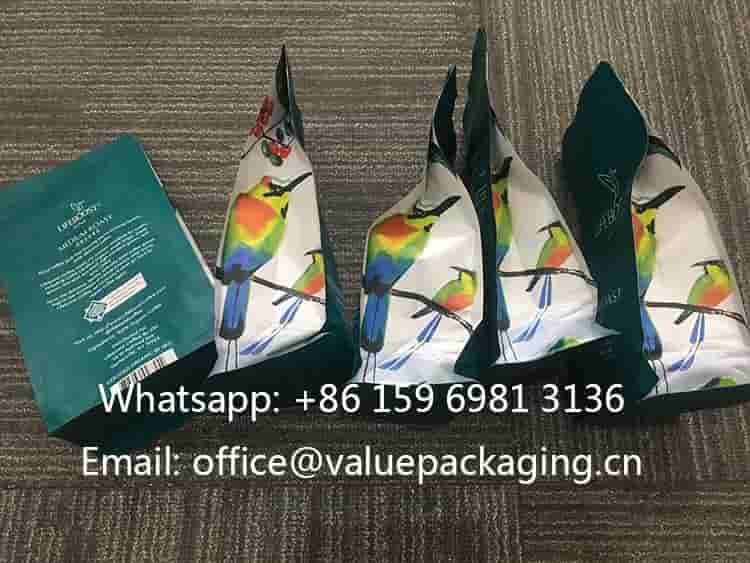
nonbroken-24oz-coffee-bag-after-drop-test-5times
4.7 Hard Sudden Strikes on inflated coffee bags

hard-strike-on-inflated-coffee-bag
Hard sudden strikes should be taken as a more fierce test method than drop test, as it causes much higher force on inflated packages.
Let’s watch the video to understand how we perform this test in our manufacturing plant.
4.8 Anti-Pressure Test
Pressure-resistance test is another effective method to decide if the final package will serve as great protection for the products, especially liquid products, like household detergent liquids, and windshield washer fluids. For coffee bags, we will perform the anti-pressure test in our daily QC work, to ensure each order is finished with great mechanical strength.
The leakage or breakage of the coffee bag will surely be a disaster, either for the distributor or the manufacturer. We will never expect this thing happens in our customer’s business.
Sometimes, for easier and fast operation, we may just get one person to stand on the well-sealed and inflated coffee bag, to check if there is any burst of them.
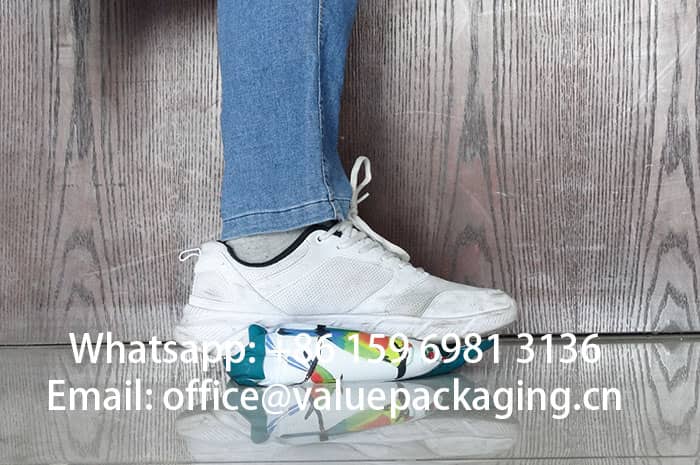
Bruce-standing-on-inflated-coffee-bag-package
4.8 Laboratory Tests
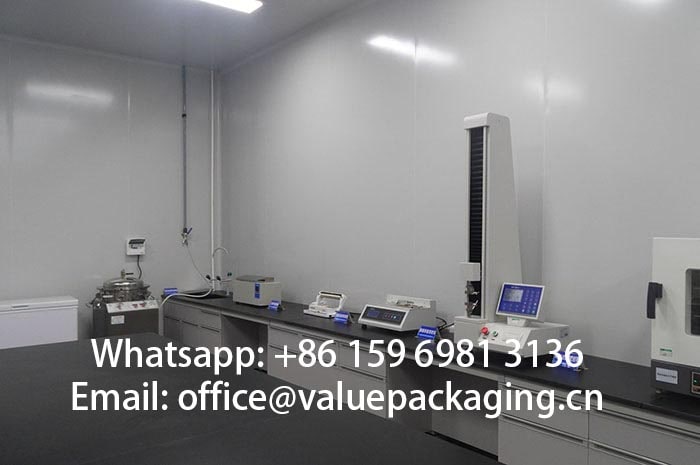
Labortory-test-equipment-tongli-packaging
Laboratory tests are essential to keep us updated with the intrinsic properties of the foil materials which are not visible to the human eyes. It is crucial for gaining a thorough understanding of the data about the production of our bags. The craftsmanship can be improved bit by bit to pursue premium quality bags based on thorough analysis and application of these data. You may check more of these tests in the Technical Data Sheet part of this post.
5 Human Food Safety
All the film materials, inks, adhesives, and solvents used to convert into kinds of food bags and packaging materials will comply with the regulations for human food safety. The below graphic shows the mass spectra in migration tests on these multilayer flexible pouches these are in direct contact with foods.
Through the below link, you will be able to study the certificates on each of the materials adapted in our factory.
6 Dieline of 24oz box bottom coffee bag

24oz-boutique-red-coffee-bag
The die-line of this 24oz box bottom coffee bag is essential when the customers want to achieve a fantastic artwork design for their package. All the details, like dimension, valve position, zipper position are well stipulated in this die-cut line.
We attach the editable PDF file here, and the customer can just download and forward it to his designer for further creative work.
Design Template24oz coffee beans W125XH230+Gusset80+Flat Bottom Pouch
7 Technical Data Sheet of 24oz aluminum foil flat bottom coffee bag
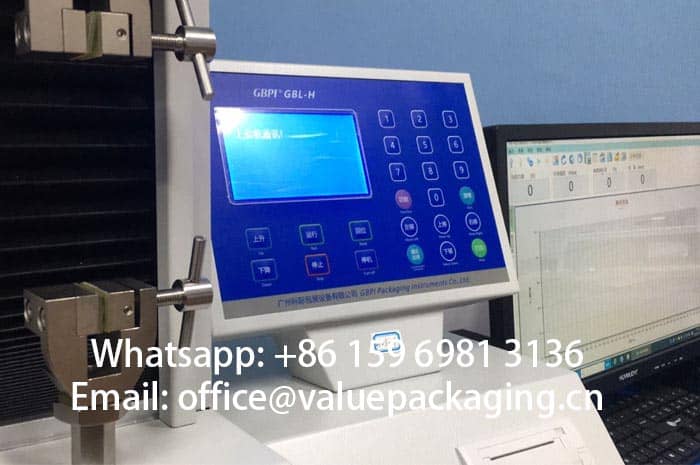
Laboratory-test-flexible-roll-foil
Here, we include the specifications on some main items of this multilayer coffee bag, with the videos showing the test progress in the later columns.

technical-data-specification-sheet-with-test-videos
You may check attached PDF file for a further knowledge on the specifications of this 24oz aluminum foil coffee bag.
TL-549 Technical Data Sheet of 24oz boutique red coffee bag
Some main items are listed below.
- Dimension Tolerance
- Print Appearance
- Yield (grams per square meter)
- Tensile Strength (Mpa)
- Elongation Rate (%)
- Coefficient of friction, short as COF
- Solvents Left (mg/m2 )
- Sealing Strength (N/15mm)
- Sealing Conditions
- Bond Strength (N/15mm)
- Burst Strength (J)
- Anti-Puncture ability (N)
- Drop Test Ability (cm)
- Anti-pressure ability (kgs)
- Water Vapor Transmission Rate (g/m2/24hr)
- Oxygen Transmission Rate (cc/m2/24hr)
Just reach us if you have any questions with any of the items.
8 More Sustainable Options
With the increasing burden on plastic pollution, more and more manufacturers are now seeking more sustainable packages, like compostable film materials, recyclable mono materials packages, and plant-based materials packages. They all prove to be more eco-friendly and sustainable than the traditional plastic films which are usually derived from fossil chemicals, and very difficult to recycle and break down in the environment.
Here, we are going to share some of the trending sustainable packages for the coffee market.
8.1 Compostable film material packages
Thanks to the fast development of plant-based film materials, we can present the multi-layer standup pouch and roll foils in full compostable and biodegradable options.
The compostable substrate films we adapt to convert the multi-layer flexible pouches are listed below.
- BOPLA Film
- PLA+PBAT Film
- Kraft Paper
- Metallized Paper
- Cellulose Film
- Metallized Cellulose Paper
- PBS Film
- PVDC Coated Cellulose Film
- Metallized BOPLA Membrane
We are now achieving multilayer compostable foil materials based on extrusion coating lamination, solvent-free lamination and dry lamination, and then convert into various types of flexible pouches against customers’ requirements.
Some of the common compostable foil structures are listed below.
- Kraft Paper/PLA+PBAT Membrane
- Kraft Paper/BOPLA Membrane
- Cellulose/PLA+PBAT Membrane
- Kraft Paper/PBS Foil Membrane
- Metallized Paper/PLA+PBAT Membrane
- BOPLA/PLA+PBAT Membrane
- Cellulose/Metallized Cellulose/PLA+PBAT Membrane
- Kraft Paper/Metallized Cellulose/PLA+PBAT Membrane
- Cellulose/Metallized Paper/PLA+PBAT Membrane
- Kraft Paper/Cellulose/PLA+PBAT Membrane
- Kraft Paper/Cellulose/PBS Membrane
- Metallized Paper/Cellulose/PLA+PBAT Membrane
Here, we are going to introduce the main performance of these compostable materials pouches.
a. Compostable
All the film materials we adapt are certificated compostable, under home or industrial conditions, complying with the standards EN 13432 or ASTM 6400.
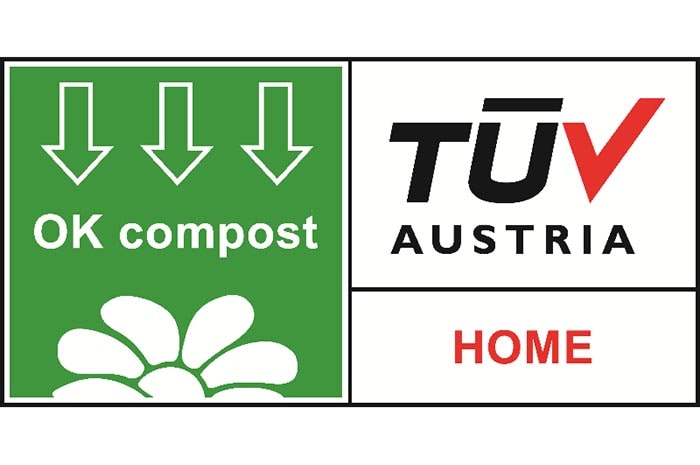
The films will present different biodegradation behaviors under different conditions, such as industrial composting facilities, home and garden conditions, and nature soil conditions.
 In most cases, industrial composting will be able to achieve a faster biodegradation of the compostable film materials than other composting progress, as it is able to provide better conditions.
In most cases, industrial composting will be able to achieve a faster biodegradation of the compostable film materials than other composting progress, as it is able to provide better conditions.
Some manufacturers would like to have a better biodegradation behaviors of their own compostable packages under nature soil conditions, as in most cases, the abandoned package may not be recycled into human composting facilities.
You may read here to have a better understanding of the break-down progress of our compostable foil laminated materials under the nature condition in Qingdao, Shandong, North China conditions.
The biodegrading process of compostable film materials buried in nature soil
b. High-barrier performance pouches
Through vacuum metallization, PVDC coating, and AlOx/SiOx depositing, the compostable films can be achieved with better barrier performance, such as water vapor transmission rate (short as WVTR) and Oxygen Transmission Rate (short as OTR). Later on, we will combine several layers of the barrier film and convert into laminate foil, with an improved barrier property for finished packages.odles, or soup products
In below table, we are going to share some barrier data of the most common foil laminates tested on our Mocon permeation tester.
| Biodegradable Foil Laminate | WVTR (g/m2/24hr) | OTR (cc/m2/24hr) |
| BOPLA40/PLA+PBAT60 | 62.2 | 267 |
| Cellulose30/PLA+PBAT60 | 131.5 | 5.6 |
| Kraft Paper45g /PLA+PBAT60 | 44 | 742 |
| Kraft Paper45g/BOPLA40 | 41 | 380 |
| Metallized Paper69g/PLA+PBAT40 | 27 | 127 |
| Cellulose30/Metallized Cellulose20/PLA+PBAT60 | 23 | 0.16 |
| Cellulose30/Metallized Cellulose20/BOPLA40 | 25 | 0.12 |
| Metallized Paper 69g/Cellulose30/PLA+PBAT60 | 5.6 | 1.12 |
| Kraft45g/Metallized Cellulose20/PLA+PBAT60 | 26 | 0.22 |
| Cellulose30/Kraft45g/PLA+PBAT60 | 19 | 117.2 |
| Cellulose30/Metallized Paper69g/PLA+PBAT60 | 8.9 | 1.1 |
c. Alkaline Resistant
We put a certain amount of bleaching powder into the compostable pouches with various foil structures, and place them in an environment of 40~45 Celsius degree, to accelerate the aging process of the compostable pouches.
The test result proves the compostable pouches will be fine for packing alkaline products, like household detergent powder, and hand wash cubes.
However, it is not ok for household liquid detergent and other liquid cleaning chemicals.
You may watch the video below for further knowledge on it.
d. Frozen Treatment
The compostable pouches can be well intended for frozen treatment for some food products, and the mechanical property of the frozen pouch still works well as good protection for the products during the transportation and distribution process.
You may watch the video below to study the test in our office.
d. Vacuum Packages
The compostable pouches can be intended for vacuum packages for products, like milk powder, nutrition products, etc.
f. Hot Filling up to 100 Celsius Degree
The compostable pouch will be fine for the hot filling process, which may work well for juice products.
Watch the video below to learn our test.
g. Microwave Oven Treatment
The compostable doypack can be well intended for microwave oven treatment, such as melting the candle wax, etc.
Please note, there should not be metalized film layer in the compostable pouch when it is intended for this microwave treatment purpose.
You may read here for better understanding on the compostable plant-based film materials packaging.
8.2 Mono Materials Recyclable Pouch Packages

804-matte-black-mono-materials-standup-doypack-with-zipper-coffee-bag-250g
Mono-material pouches are truly recyclable, as they can be easily processed into plastic granules and reused for other applications. In contrast, traditional multilayer laminates, such as PET/LDPE, are more difficult to recycle due to the distinct properties of PET and LDPE, which cannot be melted under the same conditions. This is why mono-material pouches are gaining widespread popularity in the packaging industry and receiving high praise in the consumer market.
Currently, mono-material pouches are primarily categorized into Polyethylene (PE) and Polypropylene (PP) types, with polyethylene being the more popular choice due to its ability to be converted into a variety of stand-up pouches with high performance.
Below, we outline the film materials that are well-suited for mono-material recyclable pouch packaging.
- MDOPE Film
- BOPE Film
- APE Film
- LDPE Film
- LLDPE Film
- CPE Film
- ABOPP Film
- CPP Film
- VMCPP Film
- VMBOPP Film
- EVOH-LDPE Film
- HDPE Film
Various foil laminates can be achieved based on the above film materials with different properties, which are intended to meet the particular requirements for specific products. Some of the common mono-material foil laminates are listed below.
- MDOPE/APE
- MDOPE/LDPE
- MDOPE/EVOH-LDPE
- MDOPE/HDPE/APE
- MDOPE/BOPE/APE
- BOPE/APE
- BOPP/CPP
- BOPP/VMCPP
- ABOPP/VMCPP
From our experience, mono-materials pouches can be well intended for spices powder products.
You may have a further understanding of the recyclable mono materials and pouches here, and just reach us if you have any questions
11 About the manufacturer
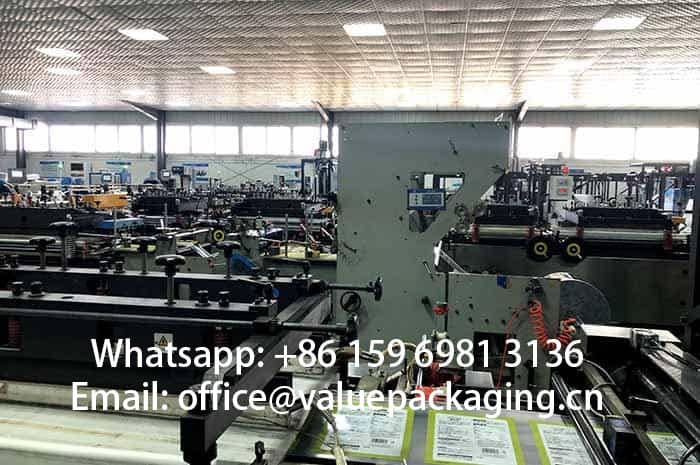
bag-making-department
Qingdao Tongli Packaging has devoted itself to the manufacture of quality coffee bags for more than 10 years, with long-term customers around the world. You may just rely on us if you would like to get a sustainable and reliable supply for your coffee packages.


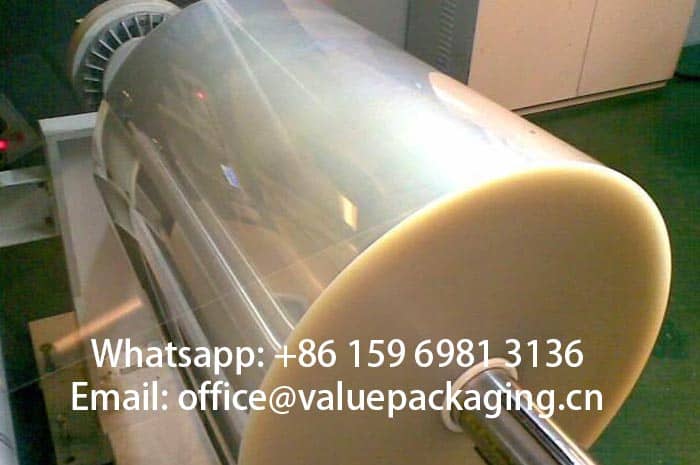

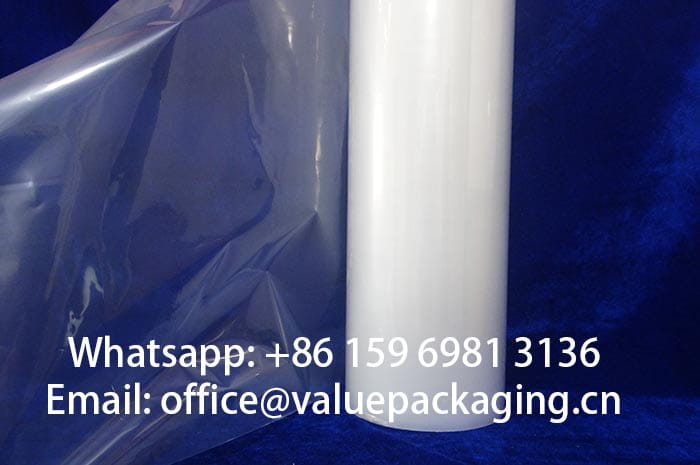
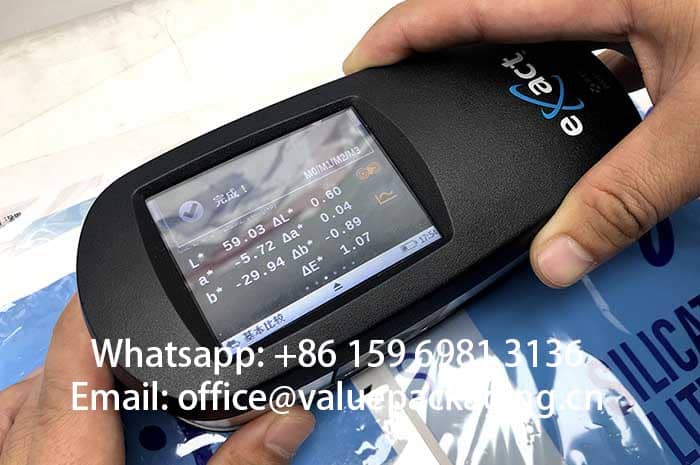

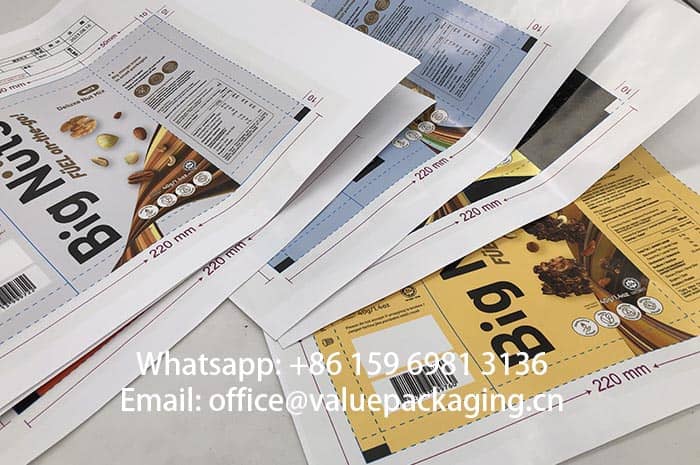
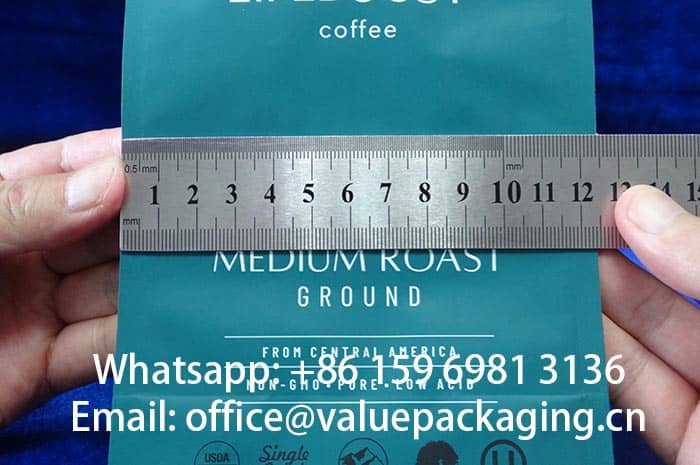
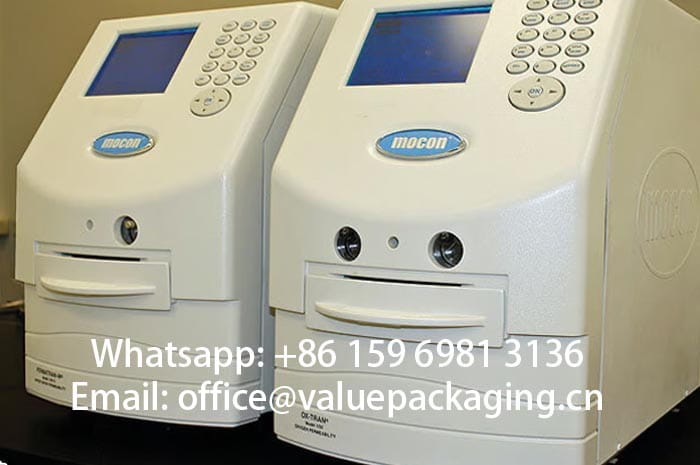
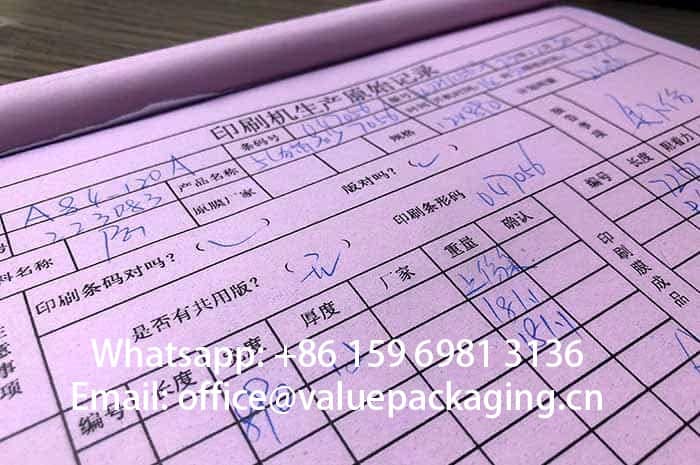
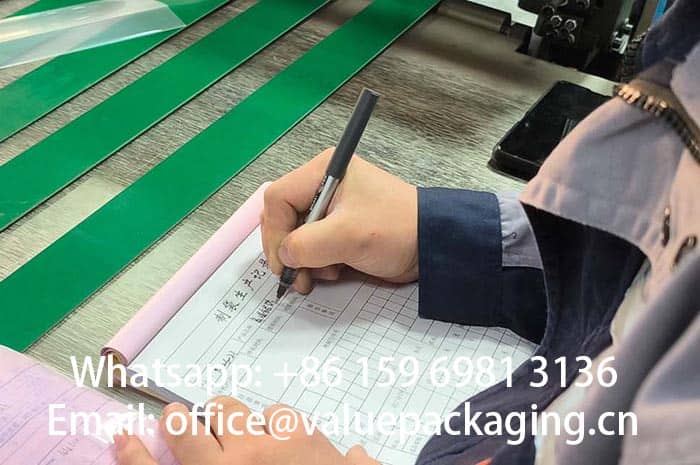
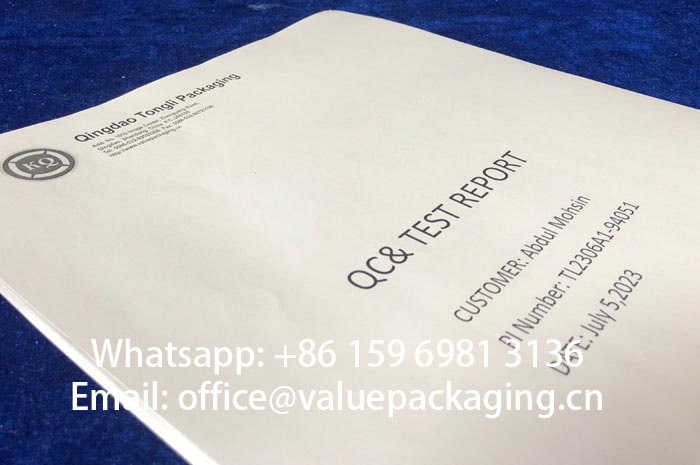
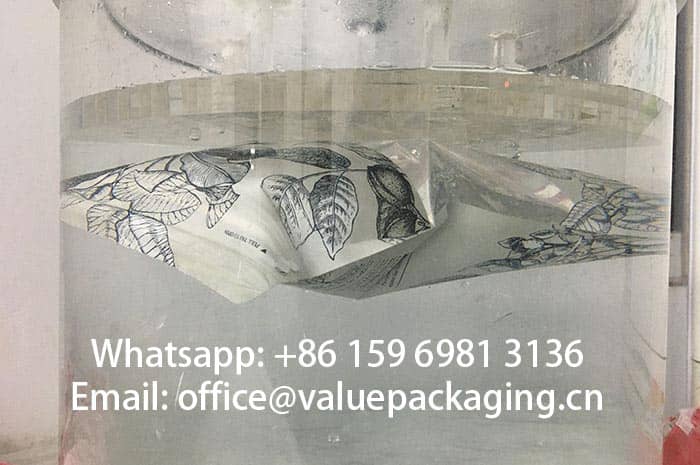



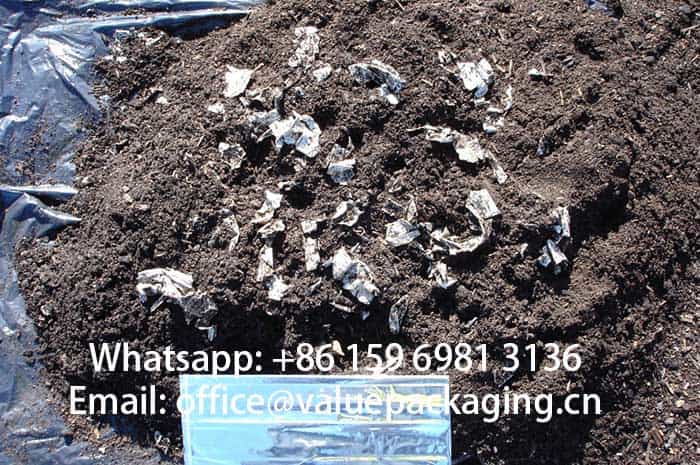
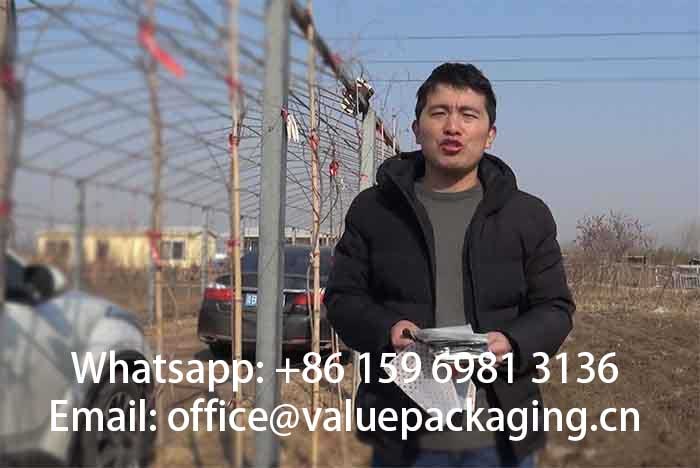

Reviews
There are no reviews yet.